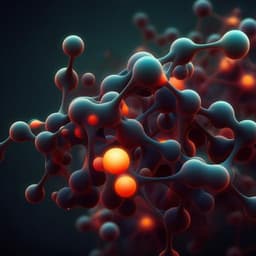
Engineering and Technology
Nanoengineering of cathode layers for solid oxide fuel cells to achieve superior power densities
K. Develos-bagarinao, T. Ishiyama, et al.
Discover how advanced nanoengineering innovations by Katherine Develos-Bagarinao, Tomohiro Ishiyama, Haruo Kishimoto, Hiroyuki Shimada, and Katsuhiko Yamaji lead to remarkable performance enhancements in thin-film cathodes for solid oxide fuel cells, achieving unprecedented current densities at elevated temperatures. Join us in exploring the future of sustainable energy!
~3 min • Beginner • English
Introduction
The study addresses the challenge of reducing SOFC system cost by increasing power density through advanced cathode design. Conventional SOFC cathodes made by screen-printing are limited by polarization losses and oxygen exchange kinetics, while thin-film approaches have shown promise for lowering area-specific resistance (ASR) but face issues of long-term stability, grain coarsening, surface segregation, and poor lateral conductivity. Prior work has demonstrated nanoscale engineering (e.g., PLD and sol–gel) can enhance oxygen exchange, yet most efforts focused on initial performance rather than durability and practical cell integration. Additionally, while LSC-GDC and SSC-SDC nanocomposites have been grown by PLD, LSCF–ceria nanocomposites via PLD have not been reported. The purpose of this work is to develop a nanoengineered cathode architecture that combines a self-assembled, highly ordered LSCF-GDC nanocomposite transition layer with a nanoporous LSC top layer to maximize interfacial density, oxygen ion transfer, and gas-phase access, and to integrate these into anode-supported cells to realize superior power densities at intermediate temperatures.
Literature Review
- Thin-film and nanoengineered cathodes prepared by PLD can exhibit low ASR and high oxygen exchange compared with conventional screen-printed cathodes, but long-term stability is often not addressed.
- Sol–gel routes have achieved record-low ASR for nanoscaled LSC cathodes, indicating processing route strongly influences performance.
- Combining perovskite cathodes (LSC or LSCF) with good ionic conductors (e.g., rare-earth-doped ceria) as nanocomposites can enhance interfacial area and facilitate oxide ion transfer, reducing polarization resistance. Successful PLD growth was reported for LSC-GDC and SSC-SDC, but not for LSCF–ceria composites prior to this work.
- Key degradation issues for thin-film cathodes are thermally induced grain coarsening and surface segregation at high temperature, degrading oxygen surface exchange kinetics. Thin-film cathodes also suffer from intrinsically poor lateral conductivity and challenges in current collection with nanometer-scale grains.
- Reported literature shows that adding GDC to LSCF can have positive or negative effects depending on preparation method, film thickness, porosity distribution, and percolation of the ionic phase. This motivates controlled nanoarchitecture via PLD to achieve ordered, high-interfacial-density composites and to pair them with porous layers for gas access.
Methodology
Materials and architecture:
- Cathode concept: a bilayer composed of (i) a dense, self-assembled LSCF-GDC nanocomposite transition layer (~0.3 µm) directly on a dense GDC interlayer (~2 µm), and (ii) a nanoporous LSC top layer (~1 µm). The nanocomposite provides increased interfacial density and adhesion; the LSC layer supplies high surface area and fast surface exchange.
- Cell platform: anode-supported cells with Ni-YSZ support (~50% porosity), a Ni-YSZ anode functional layer (AFL), a thin YSZ electrolyte (~2 µm), a dense GDC interlayer (~2 µm), then the LSCF-GDC nanocomposite and nanoporous LSC cathode layers.
Thin-film growth by PLD (NanoPLD, PVD Products):
- LSCF-GDC nanocomposite: single-step PLD from a sector target (LSCF : GDC areal ratio 3:1) ablated by a KrF excimer laser (248 nm; 200 mJ; 10 Hz). Substrate at 750 °C, oxygen pressure 5 Pa; chamber-cooled to room temperature under same atmosphere. Achieved highly ordered nanostripe self-assembly of LSCF and GDC phases (2–5 nm stripes) within granular domains spanning the film thickness.
- GDC interlayer: same PLD conditions as the nanocomposite, thickness controlled by pulse number; deposited dense and pinhole-free without post-growth sintering to avoid YSZ–GDC interdiffusion.
- LSC thin films: from LSC ceramic target at room temperature, 13.3 Pa O2, 275 mJ, 20 Hz; thickness ~1 µm. As-grown films are nanoporous with vertically aligned agglomerates separated by nanochannels; upon 700 °C anneal (1 h, air), coarsen into clustered nanopillars (50–100 nm grains) while retaining high porosity and surface area.
Microstructural/phase characterization:
- SEM (NovaNanoSEM 450, FEI) in SE and BSE modes; TEM/STEM (Tecnai Osiris, FEI, 200 kV); STEM-EDX for elemental mapping. Cross-sections prepared by FIB-SEM (Scios, FEI), final thinning <3 kV; additional Ar ion milling (Gatan PIPS 691).
- STEM-HAADF and EDX confirmed alternating LSCF (dark) and GDC (bright) nanostripes with coherent, quasi-epitaxial interfaces; SAED and XRD verified coexistence of crystalline LSCF and GDC phases.
Electrochemical testing on symmetric cells:
- Substrate/electrolyte: GDC electrolytes. Configurations: Sample 1 (unsintered LSC paste only as electrode), Sample 2 (nanoporous LSC), Sample 3 (LSCF-GDC), Sample 4 (LSCF-GDC + LSC), Sample 5 (LSCF + LSC). Unsinetered LSC paste used as current collector for all.
- EIS (Versastat4) from 1 MHz to 0.1 Hz, 500–700 °C in flowing air (50 mL/min). Active area 0.785 cm². ASR extracted by fitting (Zview).
Anode-supported cell fabrication:
- NiO-YSZ support: NiO (Sumitomo) and YSZ (TZ-8Y, Tosoh) at 60:40 wt%, with pore former and binder, mixed with water under vacuum; aged 15 h; extruded into green sheets (0.7 mm thick, 120 mm wide), punched to 32 mm diameter, sintered at 1240 °C for 2 h in air.
- AFL and YSZ electrolyte: NiO-YSZ nanocomposite powders for AFL synthesized by spray pyrolysis; AFL and YSZ pastes (with α-terpineol, ethyl cellulose, dispersant, plasticizer) screen-printed sequentially and co-sintered at 1360 °C for 3 h in air to yield electrolyte/anode half-cells (~22 mm diameter). YSZ electrolyte ~2 µm.
- PLD deposition of GDC interlayer (~2 µm), LSCF-GDC (~0.3 µm), and nanoporous LSC (~1 µm) on half-cells, using same conditions as symmetric cells.
Anode-supported cell testing:
- Configurations: Sample 6 (LSCF-GDC only), Sample 7 (LSC only), Sample 8 (LSCF-GDC + LSC). Active area 0.785 cm². Operating gases: 3% humidified H2 to anode (200 mL/min) and dry air to cathode (200 mL/min). Sealed with Pyrex ring. I–V and EIS (VSP-300). Unsinetered LSC paste as cathode current collector; Ni foam anode contact. Thermocouple near anode (~1 mm).
- Current collector study: same architecture as Sample 8 tested with Pt paste current collector in a different rig (Autolab PGSTAT302); also Sample 9 with smaller active area (0.283 cm²) tested 550–700 °C; 3% humidified H2 (70 mL/min) and air (140 mL/min). Pt paste used on both electrodes; thermocouple ~1 mm from cathode.
Durability test:
- Constant current 1 A/cm² at 700 °C for >250 h; periodic I–V, I–P, and EIS recorded.
Key Findings
- Microstructure/phase: PLD produced highly ordered, self-assembled LSCF-GDC nanocomposites with alternating nanostripes (2–5 nm wide) within granular domains across ~300 nm thickness, exhibiting coherent, quasi-epitaxial LSCF/GDC interfaces and greatly increased interfacial area density (estimated >100× relative to a simple LSCF|GDC interface).
- Nanoporous LSC: As-grown room-temperature PLD films are highly porous; after 700 °C anneal (1 h in air), transform into clustered nanopillars (50–100 nm grains) while maintaining high porosity and surface area, ensuring gas permeability and active ORR sites; good adhesion to underlying nanocomposite.
- Symmetric cell ASR (500–700 °C):
• Sample 1 (LSC paste only) shows higher ASR at 500 °C than thin-film cathode samples, indicating superior oxygen exchange kinetics of thin films.
• At 600–700 °C, nanoporous LSC layers’ performance converges with LSC paste alone, likely due to interaction between paste and nanoporous LSC at high T.
• Combining layers yields best ASR: Sample 4 (LSCF-GDC + LSC) achieves lowest ASR; at 600 °C: ~36 mΩ·cm² vs Sample 5 (LSCF + LSC) ~70 mΩ·cm² (≈50% lower), highlighting the transition layer benefit of the nanocomposite.
- Anode-supported cells (active area 0.785 cm²; OCV ~1.1 V at 600–700 °C):
• LSCF-GDC alone (Sample 6) underperforms and shows positive curvature at high currents (gas diffusion limitation from denser microstructure).
• LSC alone (Sample 7) outperforms Sample 6 but is inferior to the bilayer.
• Bilayer (Sample 8) shows highest power across 600–700 °C.
- Current collector effect: Replacing LSC paste with Pt paste improves high-T (700 °C) performance; SEM after testing shows Pt did not infiltrate nanoporous LSC, suggesting reduced measurement artefacts and better current collection at high T.
- Optimized performance (Sample 9; Pt collector; active area 0.283 cm²):
• Current densities at 0.7 V: ~2.2 A/cm² (650 °C) and ~4.7 A/cm² (700 °C), corresponding to ~1.5 and ~3.3 W/cm², respectively.
• Impedance at 0.75 V: R_ohm = 0.026 Ω·cm²; R_p = 0.030 Ω·cm²; low values attributed to thin YSZ and dense GDC interlayer plus highly active nanoengineered cathodes.
• Performance competitive with or exceeding top literature values: ~3× higher than prior best LSCF-GDC on anode-supported (700 °C), and ~20% higher than thin-film SSC-SDC composites on LSGM at 700 °C.
- Reproducibility: Independent cells with same architecture yield similar ohmic and polarization resistances and I–V characteristics across rigs, indicating consistent fabrication.
- Durability: Under 1 A/cm² at 700 °C, voltage drops sharply in first ~10 h, then stabilizes near ~0.8 V for >250 h; end-of-test I–V/I–P recorded, indicating need for stability improvements.
- Additional observation: Non-linear I–V behavior suggests activation with current density or self-heating; comparison of ohmic ASR at OCV vs 0.75 V implies self-heating unlikely; behavior may stem from nanostructure-specific effects.
Discussion
The results demonstrate that a rationally designed nanoengineered cathode stack resolves key bottlenecks in SOFC cathodes: the LSCF-GDC nanocomposite transition layer dramatically increases the electrode/electrolyte interfacial density and facilitates oxygen ion transfer across coherent interfaces, while the nanoporous LSC top layer provides abundant ORR surface sites and gas permeability. Together, they deliver very low ASR and, when integrated with a thin YSZ electrolyte and dense PLD GDC interlayer, significantly reduce both polarization and ohmic losses, enabling record-high current densities at 0.7 V at 650–700 °C on practical anode-supported cells. The study also clarifies that evaluation of thin-film cathodes is sensitive to current collector choice; Pt paste offers a more accurate assessment at high temperature than in-situ active LSC paste, which can interact with porous cathodes. The architecture outperforms prior LSCF-GDC composite cathodes and rivals state-of-the-art SSC-SDC thin-film systems, indicating that ordered, self-assembled nanocomposite layers paired with nanoporous surface exchange layers are an effective strategy for next-generation cathodes. The observed non-linear I–V behavior may indicate unique activation phenomena tied to the engineered nanostructure, meriting further mechanistic study.
Conclusion
The work introduces and validates a nanoengineered cathode architecture combining a highly ordered, self-assembled LSCF-GDC nanocomposite transition layer with a nanoporous LSC top layer, all integrated onto a practical anode-supported SOFC with a thin YSZ electrolyte and dense PLD GDC interlayer. This design achieves exceptionally low ASR and record-high current densities at 0.7 V of ~2.2 A/cm² at 650 °C and ~4.7 A/cm² at 700 °C (power densities ~1.5 and ~3.3 W/cm²). The approach surpasses prior LSCF-GDC systems and is competitive with leading SSC-SDC thin-film cathodes. Future work will focus on optimizing layer microstructures and thicknesses, refining current collection strategies for thin-film electrodes, improving long-term stability (materials and operating conditions), and further elucidating activation phenomena in the nanoengineered cathodes to guide scalable manufacturing and deployment in high-performance SOFCs.
Limitations
- Long-term stability: Initial rapid voltage drop within ~10 h at 1 A/cm² and 700 °C indicates degradation mechanisms that require mitigation for durable operation.
- Measurement artefacts: Use of unsintered LSC paste as current collector can interact with nanoporous LSC at high temperatures, obscuring intrinsic cathode performance; alternative collectors are necessary for accurate assessment.
- Gas diffusion constraints: LSCF-GDC nanocomposite alone shows gas diffusion polarization due to its relatively dense microstructure; balancing porosity and density is critical.
- Thin-film cathode lateral conductivity and current collection remain challenges for practical scaling and require optimized current collector designs.
- Interlayer/electrolyte interactions: Although PLD GDC interlayers avoid high-temperature sintering, broader comparisons with conventional porous interlayers and potential interdiffusion under long-term operation were not fully addressed.
- Anomalous non-linear I–V behavior suggests complex, not yet fully understood processes that could affect predictability and control of performance.
Related Publications
Explore these studies to deepen your understanding of the subject.







